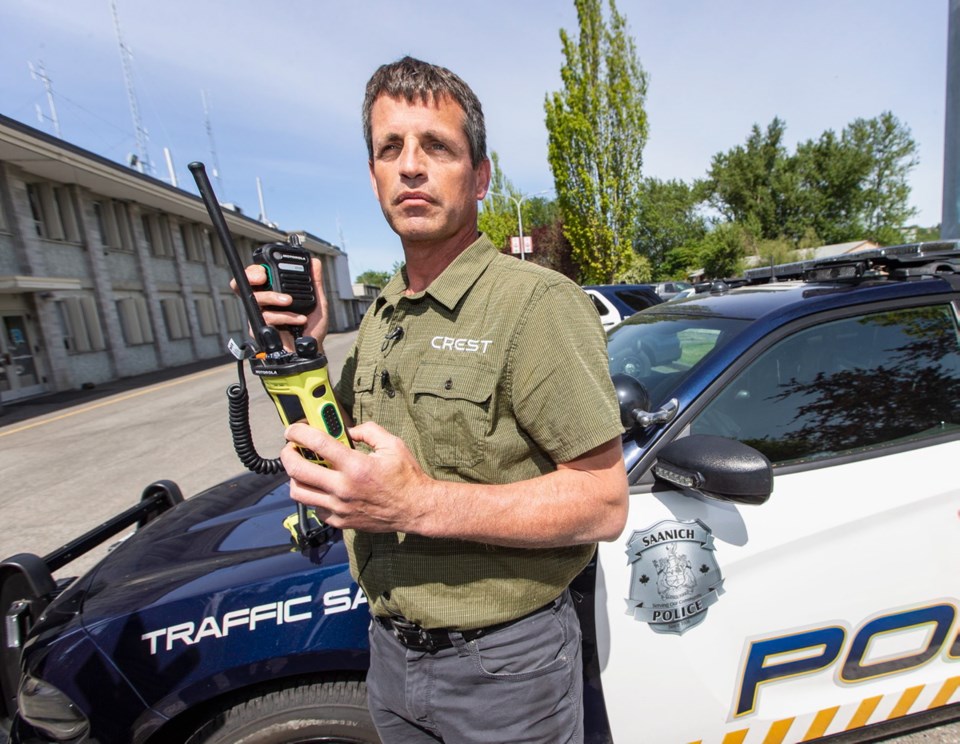After years of struggling with garbled radio broadcasts and communication dead zones, Saanich police say the new digital P25 radio system is making things safer for first responders.
The radio-signal failures have been a constant frustration for police, firefighters and paramedics, who complained that they would get nothing but static in certain high-density buildings or poor-reception areas.
Police departments in Saanich, Victoria and Oak Bay were the first to switch from an analogue-digital VHF system to the new 700 MHz network in January. The new technology will be phased in across the region until the end of this year.
The long-awaited radio improvements are part of $24.5 million in upgrades that CREST, Capital Region Emergency Service Telecommunications, hopes will eliminate gaps in radio coverage that some police departments say put them at risk. Victoria police previously patrolled in pairs because they were worried they might not be able to call for backup.
Saanich police spokeswoman Sgt. Julie Fast said officers have noticed a major difference, with clearer calls and fewer dead zones.
Before January, radios wouldn’t work in parts of the Saanich police public-safety building, Fast said.
“You’d press the talk button and you’d get static dead noise. You couldn’t reach dispatch, you couldn’t reach a fellow officer,” she said, adding that the radio is officers’ greatest public-safety tool.
“We need to have confidence that when we are calling on the radio for assistance, we’re getting heard.”
Police departments using the new system will be dispatched from the E-Comm South Island 911/Police Dispatch Centre, which officially opened in Saanich in March.
The addition of 22 new communications towers across the region means first responders will have broader radio coverage with better audio quality, said Gord Horth, CREST’s general manager.
“They have transmission towers in those areas to account for the coverage challenges they had in the past,” he said.
The new infrastructure has increased radio capacity by 30 per cent, which Horth said is crucial for dealing with a heavy call-load in the event of a major earthquake or natural disaster.
“There will certainly be less frustration in areas where they did have coverage challenges,” he said.
Horth said no radio system is perfect and there will likely be communication challenges during the switchover to the new system across the region, but he expects the overall communication quality will be much better across the board.
Fire departments in Victoria, Saanich, Esquimalt and Oak Bay will switch to the new radio system in June.
Esquimalt Fire Chief Chris Jancowski said there are many coverage gaps with the current VHF system, including inside Esquimalt municipal hall.
Jancowski said tests last summer with the P25 radio system were encouraging. “We’re cautiously optimistic it’s going to provide better service and we’re looking forward to going live and testing some of these areas,” he said.
First responders on the Saanich peninsula will be using the new radio system by the end of the summer, followed by the West Shore in the fall. The Gulf Islands and the Juan de Fuca area past Sooke will be the last areas to switch at the end of 2019.
Created in 2003 at a cost of $17 million, CREST provides radio and communication services to more than 50 police, fire, ambulance and other emergency response and public service agencies.
First-responder agencies pay for the radio service through an annual fee, which is determined based on geographic size of the area they cover, population and radio traffic.
The system upgrades were funded through a 2.9 per cent per year fee increase over five years, starting in 2016.



